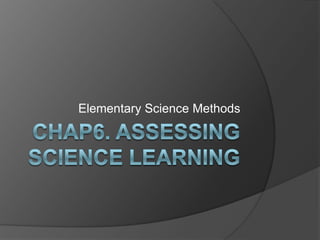
Chapter 6 assessment
- 1. Chap6. Assessing science learning Elementary Science Methods
- 2. Assessment vs. Evaluation Often both are used interchangeably. Assessment: a process of gathering information about student learning for decision making. Evaluation: typically a broader concept; focuses on the overall experience. We’ll use “assessment” to discuss student learning.
- 3. Who uses Assessment? (p. 139) Teacher Students Parents District State National
- 4. Assessment & Inquiry Science Key questions (NRC, 2001) Where are students trying to go? Where are students now? How are students going to get there?
- 9. Formative
- 11. AlternativeFormal vs. Informal (questioning, experience charts, science record pages, science notebooks, checklists) => Depend largely on the type of objectives
- 12. Diagnostic Assessment before starting teaching. to discover needed information about your students’ knowledge, interests, abilities, and preferences. help teachers adjust instructional strategies to students’ individual differences and decide learning experiences that encourage students’ progress.
- 13. Formative Assessment collect data on student learning during a lesson. include formal and informal processes. link to scaffolding to provide feedback to teachers and students over the course of instruction. to modify instruction and the curriculum to the benefit of the learner.
- 14. Summative Assessment Cumulative. generally takes place after a period of instruction. requires making a judgment about the learning that has occurred (e.g., by grading or scoring a test or paper) .
- 15. Traditional Assessment Approach Unit or chapter homework Quizzes Tests (true/false, matching, multiple choice, completion, short-answer, essay, etc.) Standardized tests
- 16. Alternative Assessment Approach Assessments that differ in form than traditional paper-and-pencil assessments. Addresses different learning / testing styles. i.e. build a frame to hold an egg so it does not crack or break when dropped 20 vertical feet.
- 17. Alternative Assessment Approach Portfolios Oral/Written Pictorial Interpretations Anecdotal Records Concept Mapping Science Journals Performance Assessment Laboratory Practical
- 18. 1. Portfolio Assessment A purposeful and representative collection of student work that conveys a story of progress, achievement and / or effort. student is involved in selecting pieces of work. criteria for selection and evaluation need to be made clear prior to selection.
- 19. 2. Oral/Written Pictorial Interpretations Ask students to respond to pictorial situations Song et al. (2008)
- 20. 3. Anecdotal Records Teacher generated notes related to student academic progress, behavior, emotional development, or social development. Useful in explaining and / or justifying student progress. Includes specific dates, times, events, etc.
- 21. 4. Concept Mapping Learners organize their knowledge into connected network, “knowledge structures” Involves the use of central themes, ideas, or concepts and juxtaposing them to reflect interrelationships.
- 24. 5. Science Journals (Notebooks) Student generated Record of thoughts, reflections, and work Can be used to demonstrate conceptual understanding
- 25. 6. Performance Assessment Assessments that allow students to demonstrate their understandings and skills (to a teacher or an outsider) as they perform a certain activity. They are evaluated by a teacher or an outsider on the quality of their ability to perform specific tasks and the products they create in the process. E.g., model building, demonstrations, projects, science fair projects
- 26. 7. Laboratory Practical Used to assess specific knowledge related to laboratory experiences. Often set up as stations where students answer questions or perform specific tasks. Type of performance assessment.
- 27. * Scoring guide: Rubrics A type of scoring guide consisting of a number of evaluative criteria that are precisely describe according to level of quality, usually with points assigned to each level.
- 28. Outcomes of Teacher’s Assessment Strategies Inform and Evaluate Student Progress Improving Classroom Practice Planning Curricula Developing Self-directed Learners Researching Teaching Practice
- 29. Reporting Student Progress Progress reports provide information about: The teacher's performance standards and criteria for evaluation. A student's progress from marking period to marking period and from year to year. A student's progress in mastering the science curriculum. A student's achievement measured against standards-based criteria.
- 30. Assessment at District, State or National Levels Assessments may be conducted by authorities external to the classroom for the purposes of: Formulating policy. Monitoring the effects of policies. Enforcing compliance with policies. Demonstrating accountability. Making comparisons. Monitoring progress toward goals.
- 31. Final Thoughts on Assessment Be sure your assessment is authentic Be fair in assessment practices Communicate expectations with your students Use multiple formats Assess students’ knowledge, understanding, and abilities to inquire